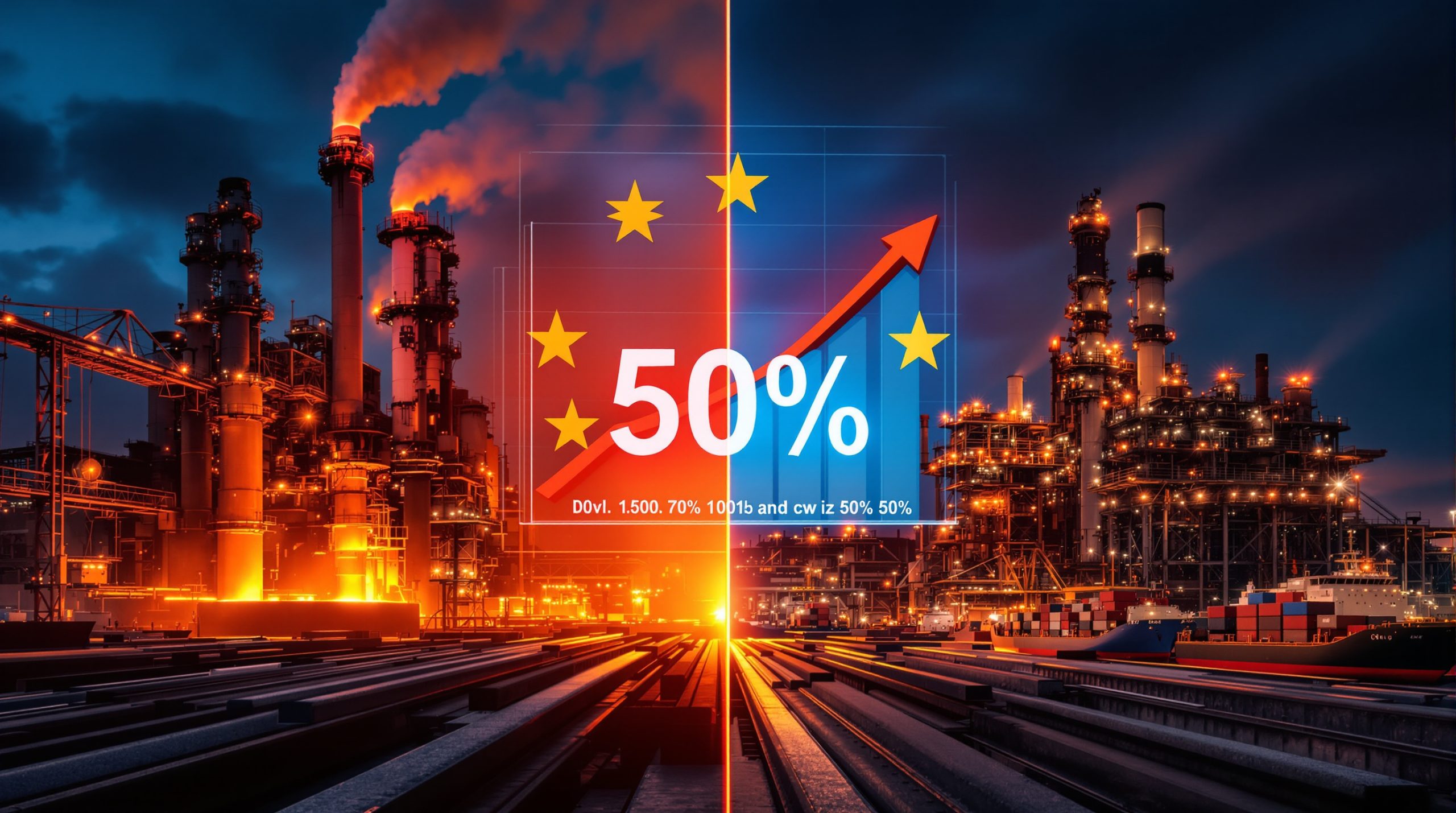Understanding the EU CBAM Impact on Aluminium P1020A Premium
The European Union's Carbon Border Adjustment Mechanism (CBAM) represents a significant shift in climate policy that will reshape aluminium markets beginning January 1, 2026. This transformative regulation aims to create a level economic playing field while advancing climate goals through targeted carbon pricing on imports. For aluminium industry stakeholders, understanding how CBAM costs will be integrated into premium assessments is critical for future market participation.
The Fundamentals of CBAM
CBAM stands as a pioneering climate policy designed to prevent carbon leakage by imposing carbon-related costs on imported goods. For the aluminium industry, this mechanism creates an entirely new financial landscape that will fundamentally alter pricing structures across European markets starting January 1, 2026, when the definitive implementation period commences.
The timing of CBAM's introduction aligns with the EU's broader climate objectives, establishing a framework where carbon costs become an intrinsic component of aluminium transactions. This regulatory approach aims to harmonize carbon pricing between EU producers—already subject to carbon costs under the EU Emissions Trading System (ETS)—and international suppliers who may operate in regions with less stringent environmental regulations.
How CBAM Affects Aluminium Markets
The introduction of carbon emission costs for aluminium imports creates a new cost element that market participants must integrate into their transaction strategies. While European producers have long factored carbon costs into their operations through the EU ETS, CBAM extends this financial consideration to all market participants bringing aluminium into EU markets.
According to the Fastmarkets proposal document from October 2025, CBAM costs will vary significantly based on "the brand and origin; when the material is customs cleared and the CBAM cost at that time; and how much of the carbon cost is paid in the origin market." This variability means traders will need sophisticated carbon tracking capabilities to accurately evaluate pricing implications.
Proposed Changes for Aluminium Premiums
Current Premium Structure vs. Proposed Changes
Aluminium P1020A premiums currently reflect various market factors including logistics, warehousing costs, regional supply-demand dynamics, and existing duty costs. The proposed change would integrate CBAM-related carbon costs directly into premium assessments for key European markets—specifically Italy and Spain—mirroring how existing import duties are already reflected in these benchmarks.
This integration approach creates a single, comprehensive price signal rather than separating carbon costs as a distinct component. The goal is to reflect the actual transaction prices in the spot market, acknowledging that CBAM certificate costs may not always be fully passed from seller to buyer.
Key Premium Assessments Affected
The proposal specifically targets two benchmark assessments that serve as key pricing references for European aluminium markets:
- MB-AL-0316: Aluminium P1020A premium, fca dp Italy ($/tonne)
- MB-AL-0319: Aluminium P1020A premium, fca dp Spain ($/tonne)
Both assessments would be modified to explicitly include CBAM costs within their specifications, with implementation timed to coincide with the start of CBAM's definitive period in January 2026. The scope includes high-purity P1020A aluminium ingot (99.7% minimum Al purity) in minimum 100-tonne transactions for delivery within four weeks.
Market Pricing Mechanism Changes
Integration vs. Separate Tracking
The proposed methodology would embed CBAM costs directly into premium assessments rather than tracking them as separate components. As stated in Fastmarkets' proposal: "Fastmarkets would not look to price individual brands or provide a standalone CBAM reference, but would provide regular updates in pricing rationales and news to provide clear visibility to the fluctuating impact and costs of the regulation on the premiums."
This contrasts with alternative approaches where carbon costs might be separately reported, potentially offering different advantages for contract structuring and price transparency.
Market-Driven Approach
The proposal emphasizes that premium assessments would reflect actual market trading patterns, meaning CBAM certificate costs may not always be fully reflected in transaction prices. The document notes: "This means the CBAM certificate costs may not always fully be reflected or passed on from seller to buyer in the spot fca dp prices."
This market-driven methodology acknowledges several important realities:
- CBAM costs will vary significantly by brand and geographical origin
- Timing of customs clearance affects applicable CBAM rates
- Market dynamics determine how much of the carbon cost is ultimately reflected in transaction prices
- Competitive factors may prevent full pass-through of carbon costs
Practical Implications for Market Participants
Trading Impact Analysis
For traders and market participants, the inclusion of CBAM costs in premium assessments creates a more comprehensive benchmark reflecting the total cost of delivered aluminium. This integration simplifies price discovery for spot transactions but requires new approaches to contract structuring and risk management.
Market participants will need to develop capabilities for:
- Evaluating carbon intensity differences between aluminium sources
- Monitoring EU carbon price fluctuations
- Assessing the degree of carbon cost pass-through in different market conditions
- Adjusting trading strategies to account for carbon cost differentials
Contract Structuring Considerations
The proposal to include EU CBAM costs in aluminium P1020A premium would significantly impact how aluminium contracts are structured from 2026 onward, potentially requiring:
- Revised pricing formulas that account for embedded CBAM costs
- New hedging strategies to manage carbon price volatility
- Updated risk management frameworks addressing regulatory compliance costs
- Potential separation of carbon and metal components in some contract structures
Buyers and sellers may need to negotiate new contract terms that specify how carbon costs are shared, particularly for long-term supply agreements that extend into the CBAM implementation period.
Regional Competitive Dynamics
The inclusion of CBAM costs in European premiums will likely:
- Widen the price differential between EU and non-EU markets
- Potentially advantage domestic EU producers who already internalize carbon costs
- Create new arbitrage opportunities based on carbon intensity differentials
- Shift sourcing patterns toward lower-carbon aluminium scrap pricing
These competitive shifts could significantly alter global aluminium trade flows, with potentially higher premiums in Europe compared to markets without carbon pricing mechanisms.
Comparison to Alternative Market Approaches
Alternative Methodologies in the Market
While Fastmarkets proposes integrating CBAM costs directly into aluminium premiums, not all market participants favor this approach. Alternative methodologies might include:
- Keeping carbon costs separate from metal premiums
- Developing specific CBAM cost indices for different aluminium sources
- Creating carbon-adjusted and non-carbon-adjusted benchmark prices
- Establishing origin-specific premiums that reflect carbon intensity differences
Proponents of separate carbon cost tracking argue that this approach provides greater transparency and flexibility, particularly for contracts that may include carbon cost adjustment mechanisms.
Comparison: Integrated vs. Separate CBAM Approaches
| Aspect | Integrated CBAM Costs | Separate CBAM Tracking |
|---|---|---|
| Price Discovery | Single comprehensive benchmark | Two distinct price components |
| Market Transparency | Simplified pricing structure | Clearer visibility of carbon costs |
| Contract Flexibility | Standardized approach | More customizable structures |
| Risk Management | Bundled price risk | Separate metal and carbon risk |
| Implementation Complexity | Lower for spot transactions | Higher but more granular |
| Administrative Burden | Streamlined reporting | Additional tracking requirements |
| Hedging Strategy | Composite price hedging | Separate metal and carbon hedging |
Each approach offers distinct advantages depending on a market participant's position, trading strategies, and risk management requirements.
Industry Feedback and Perspectives
Market Concerns and Considerations
The aluminium industry has expressed various perspectives on CBAM implementation and its integration into pricing benchmarks:
- Producers worry about competitive disadvantages if CBAM doesn't fully address carbon leakage
- Traders question how carbon intensity variations across brands will be reflected in pricing
- Consumers seek clarity on comparing offers when carbon costs are embedded versus separated
- Market participants need transparency on how carbon costs affect premiums
The consultation period (October 1-31, 2025) provides a formal opportunity for stakeholders to submit feedback on the proposed changes before implementation.
Industry Adaptation Strategies
Market participants are developing strategies to navigate the new pricing landscape:
- Enhanced supply chain mapping to identify carbon exposure across operations
- Development of carbon-adjusted procurement policies
- Investment in lower-carbon production technologies to minimize tariff market impacts
- Creation of new hedging instruments for carbon price risk
- Revision of contract terms to address carbon cost allocation
These strategies require significant preparation time, making early awareness of methodology changes critical for market readiness.
Implementation Timeline and Preparation
Implementation Roadmap
The proposal outlines a clear timeline for market feedback and implementation:
- Consultation period: October 1-31, 2025
- Planned implementation: January 1, 2026 (aligned with CBAM definitive period)
- No impact on historical data for affected premium assessments
This alignment with the CBAM regulatory timeline ensures that pricing methodologies evolve in tandem with the regulatory environment, avoiding potential disconnects between market pricing and compliance requirements.
Preparation Checklist for Market Participants
To prepare for these changes, market stakeholders should:
- Review existing contracts and pricing formulas for CBAM implications
- Develop systems to track carbon intensity of aluminium sources
- Engage with the consultation process to provide feedback
- Adjust risk management strategies to account for embedded carbon costs
- Establish carbon cost monitoring capabilities
- Train trading and sales teams on CBAM requirements and pricing impacts
Early preparation will be essential for smooth adaptation to the new pricing environment, particularly for contracts extending into 2026 and beyond.
Potential Impact on Global Aluminium Trade Flows
Market Restructuring Possibilities
The inclusion of CBAM costs in European aluminium premiums may trigger shifts in global trade patterns:
- Increased preference for lower-carbon aluminium sources, particularly for EU-destined material
- Potential redirection of higher-carbon aluminium to markets without carbon pricing
- Development of new pricing benchmarks reflecting carbon-adjusted values
- Greater price differentiation between low and high-carbon aluminium products
These shifts could create new trading opportunities while challenging established supply chain relationships, particularly for producers with carbon-intensive operations.
Supply Chain Adaptation Requirements
As CBAM costs become embedded in European premium assessments, supply chains will need to adapt through:
- Enhanced carbon footprint tracking across the value chain
- Revised logistics strategies to optimize carbon-adjusted costs
- New financial instruments to hedge carbon price exposure
- Potential reconfiguration of production and processing locations to maximize decarbonisation benefits
The transition period will require significant investment in carbon accounting infrastructure and potential adjustments to procurement strategies based on carbon intensity considerations.
Outstanding Questions and Challenges
Implementation Challenges
Several key questions remain about how CBAM costs will be integrated into premium assessments:
- How will variations in carbon intensity across different aluminium brands be reflected?
- What mechanisms will ensure market transparency as carbon costs fluctuate?
- How will the methodology adapt if CBAM regulations are modified?
- Will market liquidity be affected by more complex pricing structures?
These questions highlight the complexity of implementing carbon-adjusted pricing in a globally integrated market with diverse production methods and carbon intensities.
Future Methodology Considerations
The proposal acknowledges that further methodology adjustments may be necessary as CBAM implementation evolves, particularly if there are:
- Changes to EU regulations affecting CBAM
- Shifts in market practices for pricing carbon-adjusted aluminium
- Development of new financial instruments for managing carbon price risk
- Emergence of industry evolution trends for carbon accounting in metals
Fastmarkets notes that it "will continue to review its methodology and will consider additional changes if there any further amendments to the implementation of CBAM or changes to EU regulations."
FAQs About CBAM and Aluminium Premiums
How will CBAM costs be calculated for aluminium imports?
CBAM costs will be based on the verified carbon emissions associated with producing and transporting aluminium, multiplied by the prevailing carbon price under the EU ETS, minus any carbon price already paid in the country of origin. The calculation methodology creates a direct financial incentive for lower-carbon production methods.
Will all aluminium imports face the same CBAM costs?
No, CBAM costs will vary based on the carbon intensity of production, with lower-carbon producers facing lower costs. This creates a financial incentive for decarbonization across the global aluminium supply chain and may lead to price differentiation based on carbon intensity.
How will premium assessments handle fluctuations in carbon prices?
The proposal indicates that premium assessments will reflect market fundamentals, including how carbon costs are being passed through the supply chain at any given time, rather than applying a fixed calculation. Fastmarkets plans to provide "regular updates in pricing rationales and news to provide clear visibility to the fluctuating impact and costs of the regulation."
Will historical premium data be restated to include CBAM costs?
No, the proposal explicitly states that the "proposed amendment would not have any impact on historic data related to either premium assessment." This ensures data continuity while acknowledging the structural shift in market pricing beginning in 2026.
Preparing for the Carbon-Adjusted Future
The proposed inclusion of CBAM costs in aluminium P1020A premiums represents a significant evolution in metals market pricing. By integrating carbon costs directly into premium assessments, Fastmarkets aims to reflect how the market will actually trade while providing the transparency needed for effective decision-making.
Market participants have until October 31, 2025, to provide feedback on the proposed methodology changes, offering an opportunity to shape how carbon costs are reflected in benchmark aluminium prices. With implementation scheduled for January 1, 2026, the industry has a defined timeline to prepare for this fundamental shift in aluminium pricing mechanics.
As global markets continue to integrate carbon considerations into commodity pricing, these methodology adjustments represent an important step in the transition to a more carbon-aware trading environment. The approach taken for aluminium P1020A premiums may well serve as a template for similar adjustments across other metals markets as carbon border adjustments become more widespread in the energy transition outlook.
Looking for Early Insights Into High-Potential ASX Mining Stocks?
Discovery Alert's proprietary Discovery IQ model delivers instant notifications when significant mineral discoveries are announced on the ASX, giving traders and investors a crucial market advantage. Explore historic discovery returns and begin your 30-day free trial today at https://discoveryalert.com.au/discoveries/ to position yourself ahead of the market.




